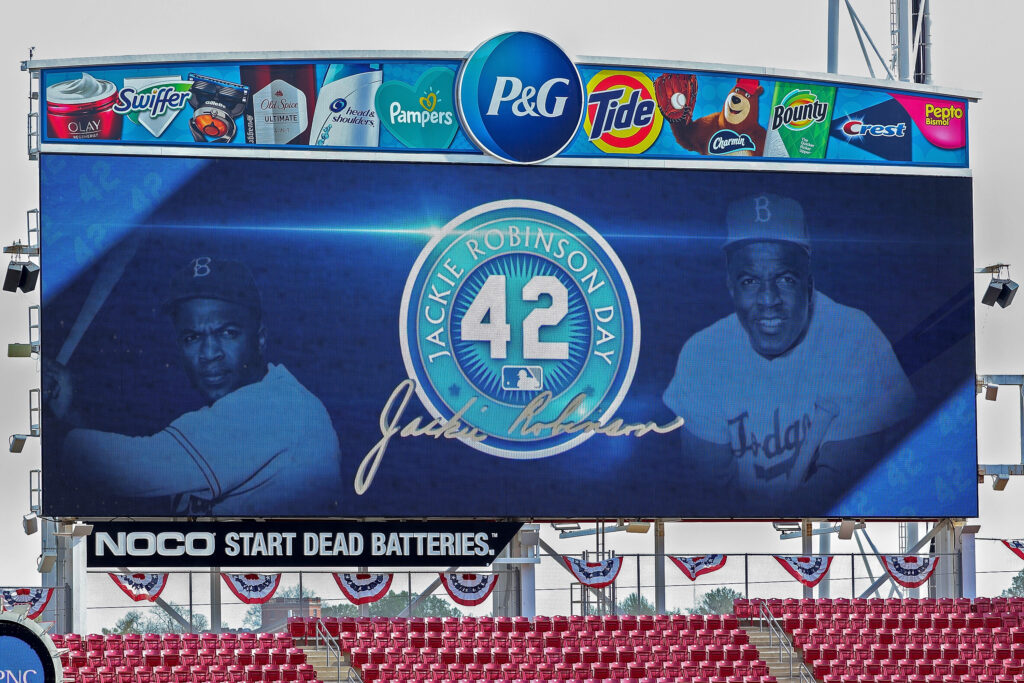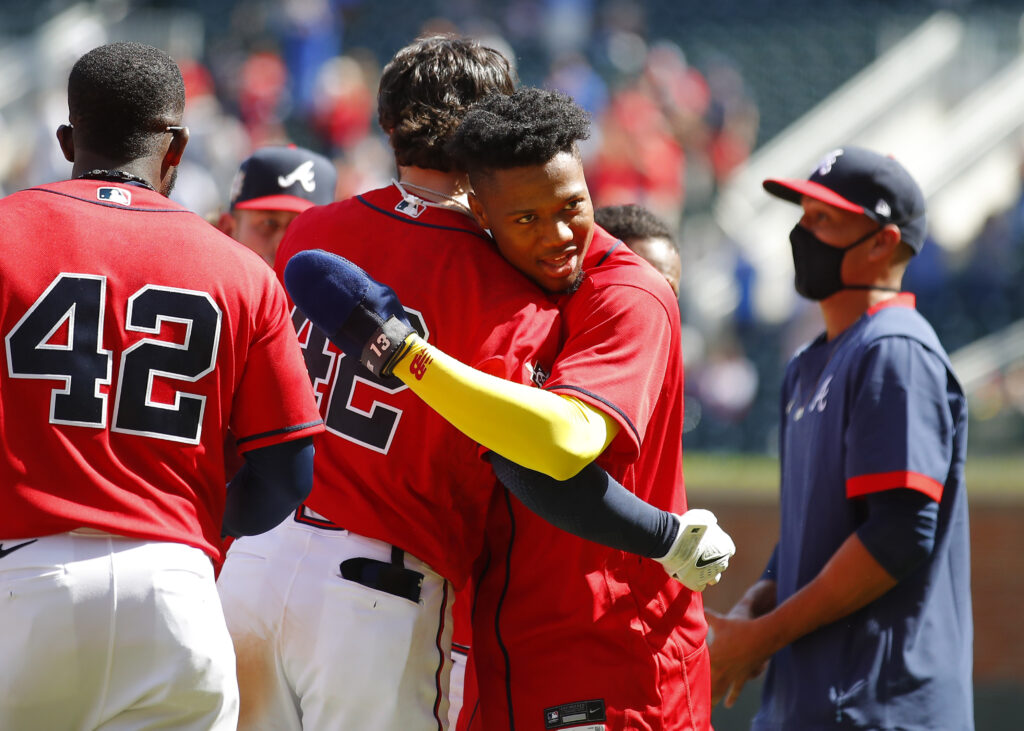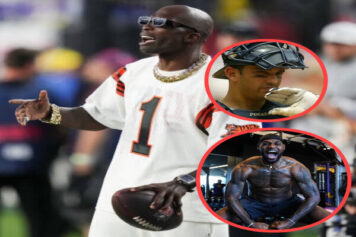On April 15, 2022, Major League Baseball celebrates another Jackie Robinson Day and also the 75th anniversary of when Robinson – a true giant in the fight against racial oppression, a politician and philanthropist – broke MLB’s color barrier in 1947, with the Brooklyn Dodgers.
Every player in the league will rock Robinson’s iconic No. 42 jersey and the tributes throughout the league will remind us of a time when nearly 20 percent of MLB rosters were Black.

(Photo by Dylan Buell/Getty Images)
Robinson burst through the glass ceiling and by 1981, 17 years removed from the Civil Rights Act of 1964, MLB saw its highest-ever Black representation at 18.7 percent, according to the Society for American Baseball Research. There are reports that the number was even higher.
The 1981 All-Star Game also had a total of 63 players, and there were 14 African-American all-stars (22 percent). So during the last four decades, the percentage of Black All-Star baseball players has decreased from 22 percent to 4.6 percent. In 2021, seven Black players made the All-Star team (9.1 percent)
SABR also shows that the number of African-American players in the MLB has fallen nearly every year since 1981, and by 2016 it plummeted to 6.7 percent, the lowest percentage since 1957.

(Photo by Todd Kirkland/Getty Images)
Fast forward to 2022 and there’s been a slight increase in African-American representation on MLB rosters. There’s also a rich pipeline of talent on the horizon, which MLB diversity leaders have told The Shadow League will create a spike in Black pros over the next 20 years.
Diversity Increase, Soul Patrol Decrease
For now, according to the latest statistics released by MLB PR, Major League Baseball’s rosters increased in overall diversity to 38 percent, up from 37.6 percent in 2021.
- 7.2 percent Black (decrease from 7.6 percent in 2021)
- 28.5 percent Latino (increase from 28.1 percent in 2021)
- 1.9 percent Asian (increase from 1.4 percent in 2021)
- 0.3 percent Native Hawaiian/Pacific Islander (decrease from 0.4 percent in 2021)
- 0.1 percent Native American (even)
As the stats show, this rise in international players has come at the expense of Black representation on MLB rosters. The population was making a comeback and pushing toward eight percent before dropping down to 7.2 percent this season.
So while diversity in any professional sports league is a good thing, the lack of homegrown African-American talent to actually reach the MLB level and stick continues to be a red flag for baseball and disrupts any cultural connection the average Black sports fan could have with baseball.
International Flavors
A total of 275 players represented 21 different countries and territories outside of the 50 United States on 2022 Opening Day rosters and inactive lists, according to MLB.
The total of 275 international players marks the most all-time on Opening Day rosters in a non-pandemic season.
The 275 players born outside the U.S. (28.2 percent) come from a total pool of 975 players (840 active 28-man roster players and 135 Major League players on injured, restricted or bereavement lists) on April 7 rosters. Opening Day and inactive list players represented 21 countries and territories by birthplace, tied with 2018 for the highest total ever.
As it has each year since MLB began releasing this annual data in 1995, the Dominican Republic leads the Majors among countries and territories outside the United States with 99 players.
The remaining countries fall like this…
Venezuela (67), Cuba (23) Puerto Rico (16); Mexico (13) Canada (12), Colombia (10, its highest total ever) Japan (7); Panama (6) Curaçao (5, tied for its highest ever); South Korea (4); the Bahamas (3, marking its first time ever with multiple players); Aruba (1); Australia (1); Brazil (1); Germany (1); Honduras (1); the Netherlands (1); Nicaragua (1); Taiwan (1); and the U.S. Virgin Islands (1).
MLB Diversity Programs Hit Homers For Bright Future
Despite the overwhelming challenges that continue to plague MLB’s efforts to inspire a life-lasting love of baseball and softball in youth from underserved communities, MLB’s diversity programs and the legendary list of devoted former stars, executives and social justice advocates in sports that run these programs, have seen solid results in a short amount of time.
In the most recent Andre Dawson Classic – MLB’s HBCU College Baseball Tournament – there was a significant measure of progress on MLB’s diversity youth baseball efforts and getting kids to the next level of the sport.
Fifty-three alumni of these programs (notably, RBI, Youth Academies, Breakthrough Series, DREAM Series, Hank Aaron Invitational) appeared on the eight team rosters of the 2022 Andre Dawson Classic.
This represented a 112 percent increase from the last Andre Dawson Classic, held in 2020.
Youth Outreach and Amateur Baseball Development programming has helped advance hundreds of young players of color, primarily African-American youth, to both professional and collegiate baseball.
Since 2015, more than 220 alumni of MLB-led baseball programming – Hank Aaron Invitational, DREAM Series, Breakthrough Series – have been drafted since 2015.
Breakthrough Series launched in 2008 and nearly 300 alumni have been drafted. Twenty of those kids have reached the Major Leagues, 10 of whom are on Opening Day rosters.
Hank Aaron Invitational launched in 2015 and nearly 50 alumni have been drafted, most notably Hunter Greene, the first HAI product to make the Major Leagues.
“He Continued To Trust His Plan”| Reds Future Black Ace Hunter Greene Shines In MLB Pitching Debut
MLB Youth Academy – Of all MLB-funded Youth Academies across the globe, the first one opened in Compton in 2006.
Compton’s YA has produced 11 Black Major Leaguers, most notably Yankees outfielder Aaron Hicks, slugger Khris Davis, the aforementioned Greene, Olympian Anthony Gose and Kyle Higashioka.
In that same timeframe, 95 percent (on average) of all participants in baseball development programs have gone on to attend college, play college baseball, or reach the professional levels.
MLB’s approach to engaging children in the Black community focuses on three tracks: grassroots, league-play and development:
Grassroots: Through the PLAY BALL initiative, MLB has connected directly with Black Churches, Boys & Girls Clubs of America and other community leaders to provide fun, interactive experiences at which kids also receive equipment to take home.
League-play: MLB continues to emphasize the growth and reach of the Reviving Baseball in Inner Cities program to offer affordable and quality league play to children of diverse backgrounds in various communities (urban, suburban and rural) around the country.
Development: MLB’s development programs – specifically the DREAM Series, Breakthrough Series and Hank Aaron Invitational – provide Major League quality opportunities for high school-age players of color to develop their skills for the next levels of the game.
The MLB Draft continues to show promising signs for a future increase in Black or African-American players.
Between 2012 and 2021, the first round of the MLB Draft featured 56 Black or African-American players out of 319 selections (17.5 percent), including a large percentage of alumni from MLB-led youth & amateur baseball development programs.
In the most well-known and respected outlets tracking 2022 MLB Draft prospects, the top-3 ranked are all players of color who have different levels of direct experience in MLB Diversity Development programming, including Termarr Johnson (RBI, DREAM Series, Breakthrough Series, Hank Aaron Invitational), Elijah Green (DREAM Series, Breakthrough Series, Hank Aaron Invitational) and Druw Jones (DREAM Series).
In 2021, Major League Baseball committed significant financial and personnel investments with several partners to bolster efforts to increase diversity throughout baseball and decrease opportunity gaps in society, specifically with the Players Alliance and Boys & Girls Clubs of America. This is in addition to the continued steadfast support of the Jackie Robinson Foundation.
The Players Alliance: In 2021, MLB announced a significant commitment to the Players Alliance (a nonprofit organization of active and former Black Major League players) of up to $150 million dollars over a 10-year period, beginning in 2023. This long-term partnership will aim to further improve access to the sport for the Black community in an effort to improve Black diversity on the field, in managerial and coaching positions and front office leadership.
Overall, there are 635 MLB Develops alumni (graduating high school 2018 or later) that have played college baseball Approximately 90 percent of this group are Black.



